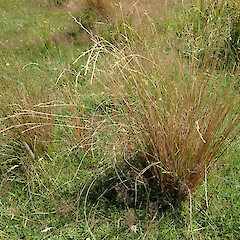Carex kaloides
Common name
sedge
Synonyms
None
Family
Cyperaceae
Flora category
Vascular – Native
Endemic taxon
Yes
Endemic genus
No
Endemic family
No
Structural class
Sedges
NVS code
The National Vegetation Survey (NVS) Databank is a physical archive and electronic databank containing records of over 94,000 vegetation survey plots - including data from over 19,000 permanent plots. NVS maintains a standard set of species code abbreviations that correspond to standard scientific plant names from the Ngä Tipu o Aotearoa - New Zealand Plants database.
CARKAL
Chromosome number
2n = c.78-84
Current conservation status
The conservation status of all known New Zealand vascular plant taxa at the rank of species and below were reassessed in 2017 using the New Zealand Threat Classification System (NZTCS) – more information about this can be found on the NZTCS website. This report includes a statistical summary and brief notes on changes since 2012 and replaces all previous NZTCS lists for vascular plants.
Please note, threat classifications are often suggested by authors when publications fall between NZTCS assessment periods – an interim threat classification status has not been assessed by the NZTCS panel.
- Conservation status of New Zealand indigenous vascular plants, 2017 . 2018. Peter J. de Lange, Jeremy R. Rolfe, John W. Barkla, Shannel P. Courtney, Paul D. Champion, Leon R. Perrie, Sarah M. Beadel, Kerry A. Ford, Ilse Breitwieser, Ines Schönberger, Rowan Hindmarsh-Walls, Peter B. Heenan and Kate Ladley. Department of Conservation. Source: NZTCS and licensed by DOC for reuse under the Creative Commons Attribution 4.0 International licence.
2017 | At Risk – Declining | Qualifiers: DP, Sp
Previous conservation statuses
2012 | Not Threatened
2009 | Not Threatened
2004 | Not Threatened
Distribution
Endemic. South Island in the east from Marlborough to Central Otago.
Habitat
Montane to subalpine along river flats, in seepages, around the margins of lakes, ponds and tarns. Sometimes found in cushion bogs and amongst red tussock (Chionochloa rubra Zotov)-dominated wetlands. Easily overlooked because its orange yellow leaves blend in with the surrounding taller vegetation.
Detailed description
Rhizomatous; orange yellow, reddish-yellow to orange, tufted swarding sedge. Individual tufts often rather large and tussock-like. Rhizome 5 mm diameter, woody, covered in closely appressed, dark-brown, fibrous leaf-sheath remnants. Culms rising singly from rhizome, 0.3–1 m × 1 mm, at first stiffly erect, then arching and more or less spreading in upper third; trigonous, glabrous below, very finely scabrid on the angles close to the inflorescence; basal sheaths dull dark grey-brown to yellow-brown. Leaves < culms, 100–600 × 1–3.5 mm, channeled, keel well-marked, margins scabridulous near apex. Inflorescence erect, 50–180 mm long, usually compound or in large plants paniculate with distant appressed branchlets. Spikes 10–35, pale straw-coloured, usually distant, lower spikes and branchlets typically subtended by a chartaceous, long-awned bract with both keel and awn scabrid; lowermost bracts often leaf-like, > panicle in length; mostly male with perfect flowers near apex, or with mostly female with male flowers near the apex or in rare cases entirely male. Glumes > utricles, lanceolate, acuminate or awned, membranous to chartaceous, light creamy brown with a pale cream centre and rather broad hyaline margins. Utricles 4–5 × 1 mm, plano-convex, finely nerved; beak tapering, 1.5–2 mm long, winged with serrated margins; stipe 1 mm long, not contracted. Stigmas 2. Nut 2 mm, dark brown, plano-convex to biconvex, oblong, smooth.
Similar taxa
Perhaps closest to C. muelleri Petrie which differs from C. kaloides by its smaller stature, more extensively creeping swarding habit, strictly erect whitish-green, yellow-green to green tufted culms and leaves, creeping habit, and narrowly erect almost dioecious spicate inflorescences. The utricles of C. muelleri are much smaller, narrower and rather more strongly nerved.
Flowering
October–January
Fruiting
October–May
Life cycle
Nuts surrounded by inflated utricles are dispersed by granivory and wind (Thorsen et al., 2009).
Propagation technique
Easily grown by division of whole plants and fresh seed. Does best in permanently damp ground and is an ideal plant fro growing around ponds or along slow flowing stream margins in the South Island. It dislikes much competition and is intolerant of drought or excessive humidity.
Threats
A biologically sparse, naturally uncommon species which at times can be locally abundant but is otherwise scarce. Does not appear to be threatened, and can tolerate cattle browsing. However it is vulnerable to competition from faster growing, taller exotic plant species.
Etymology
carex: Latin name for a species of sedge, now applied to the whole group.
Where To Buy
Not commercially available.
Attribution
Description adapted from Moore and Edgar (1970)
References and further reading
Moore LB, Edgar E. 1970. Flora of New Zealand, Volume II. Indigenous Tracheophyta: Monocotyledones except Gramineae. Government Printer, Wellington, NZ. 354 p.
Thorsen MJ, Dickinson KJM, Seddon PJ. 2009. Seed dispersal systems in the New Zealand flora. Perspectives in Plant Ecology, Evolution and Systematics 11: 285–309.












